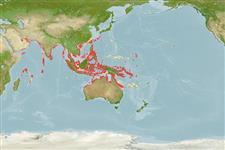Common names from other countries
分類 / Names
共通名の | 類義語 | Catalog of Fishes(部類, 種) | ITIS | CoL | WoRMS | Cloffa
板鰓亜鋼(サメとエイ類) (sharks and rays) >
Myliobatiformes (Stingrays) >
Myliobatidae (Eagle and manta rays)
Etymology: Aetomylaeus: Greek, aetos = eagle + Greek, mylio = mill, grinder (Ref. 45335).
More on author: Gray.
Environment: milieu / climate zone / depth range / distribution range
生態学
海; 汽水性の 関連する礁; 深さの範囲 1 - 18 m (Ref. 37816). Tropical; 30°N - 23°S, 51°E - 167°E
Indo-West Pacific: India to China and Indonesia.
Length at first maturity / サイズ / 重さ / 年齢
Maturity: Lm 63.0, range 54 - 72 cm
Max length : 200 cm WD オス/雌雄の選別がない; (Ref. 30573)
With distinctive color pattern and exceptionally long spineless tail over six times the length of the body (Ref. 37816).
Found inshore (Ref. 9862). Inhabits mangrove creeks and protected sandy channels to a depth of at least 18 m; relatively uncommon (Ref. 37816). Active swimmer, travelling long distances; feeds on crustaceans and molluscs (Ref. 68964). Ovoviviparous (Ref. 50449). Caught occasionally by bottom trawl, tangle net and inshore gillnet fisheries. Utilized for its meat, but of limited value as it is not frequently landed (Ref. 58048). Presumably utilized for human consumption in the western central Pacific (Ref. 9862).
Life cycle and mating behavior
Maturities | 繁殖 | Spawnings | Egg(s) | Fecundities | 幼生
Exhibit ovoviparity (aplacental viviparity), with embryos feeding initially on yolk, then receiving additional nourishment from the mother by indirect absorption of uterine fluid enriched with mucus, fat or protein through specialised structures (Ref. 50449).
Mould, B., 1994. A world list of rays. The scientific nomenclature and distribution of the recent Batoidea (Batoidea, Elasmobranchii, Chondrichthyes). University of Nottingham, [UK]. 82 p. (Ref. 8630)
IUCNのレッドリストの状況は (Ref. 130435)
絶滅危惧 (EN) (A2d); Date assessed: 29 April 2020
CITES (Ref. 128078)
Not Evaluated
Human uses
水産業: 少数商業の
用具
特記事項
XMLをダウンロードして下さい
インターネットの情報源
Estimates based on models
Preferred temperature (Ref.
115969): 25.6 - 29.3, mean 28.6 (based on 2218 cells).
Phylogenetic diversity index (Ref.
82804): PD
50 = 0.5078 [Uniqueness, from 0.5 = low to 2.0 = high].
Bayesian length-weight: a=0.00389 (0.00123 - 0.01235), b=3.08 (2.82 - 3.34), in cm Total Length, based on LWR estimates for this (Sub)family-body shape (Ref.
93245).
栄養段階 (Ref.
69278): 3.8 ±0.5 se; based on size and trophs of closest relatives
回復力 (Ref.
120179): 低い, 4.5年~14年の倍増期間の最小個体群 (Fec assumed to be <100).
Fishing Vulnerability (Ref.
59153): Very high vulnerability (83 of 100).
